Termites are a big problem and can cause significant structural damage to your home, but it’s hard to know you have a termite problem unless you physically see the annoying pests. They don’t leave any kind of “snail trail” substance behind, and most of the damage they do is inside the walls or under the floor where you can’t see it. Even their droppings look like sawdust, so how do you tell the difference?
What are the differences between termite poop and sawdust? Termite poop and sawdust look so much alike, but what makes them different is their shape. Sawdust looks more like slivers, splinters, and wood shavings. On the other hand, termite droppings are oval-shaped and six-sided, though you can only distinguish them clearly under a microscope.
For this article, we’ve pulled together everything we could think of concerning termite droppings, including what they look like, how to tell them apart from sawdust, and what to do if you find them in your house. Hopefully, the article will help you identify and deal with your termite problem before it becomes unmanageable.
What Do Termite Droppings Look Like?
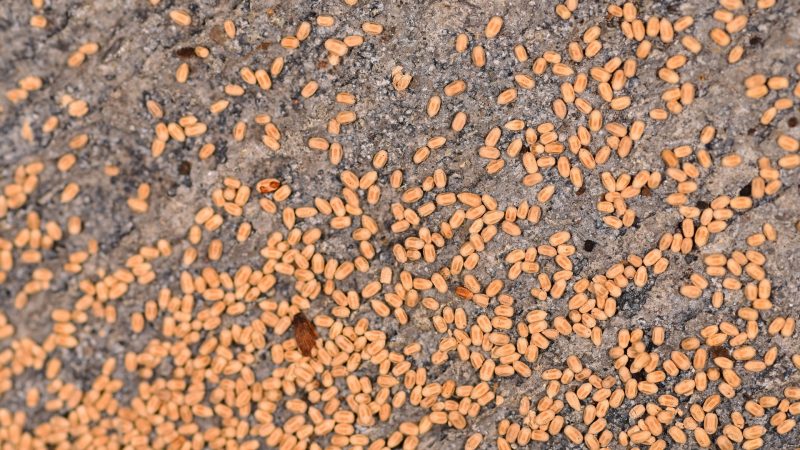
What termite poop looks like depends on what type of termites you have. If you have dry wood termites, their poop looks remarkably similar to sawdust, which is why it’s so hard to tell the two apart. You may have even spotted termite dust in the house and not recognized it for what it was.
When you see them up close, the pellets are more sand-like than sawdust-like, and when you view them under a microscope, they’re oval-shaped, have six sides with rounded ends, and are about a millimeter (0.04 inches) long.
On the other hand, subterranean termites have liquid feces that they use to construct their mud tubes. Drop tubes, exploratory tubes, and working tubes are the three types of mud tubes used by termites.
Some pest control agencies include a fourth type, known as swarm tubes, in the different varieties, but not all recognize this fourth type. You may see the mud tubes, but it’s unlikely that you’ll ever see a subterranean termite’s feces by themselves.
What Color Is Termite Poop? | Termite Droppings Color
We’re setting aside the feces used to make subterranean termites’ mud tubes and focusing strictly on dry wood termites’ droppings.
Dry wood termites’ droppings usually range in color from light brown to nearly black, and the color depends entirely on the type of wood the termites are eating. If they’re eating darker woods, you’ll find black termite droppings. If they’re eating lighter wood, the droppings will be light, as well.
Do Termites Leave Sawdust Behind?
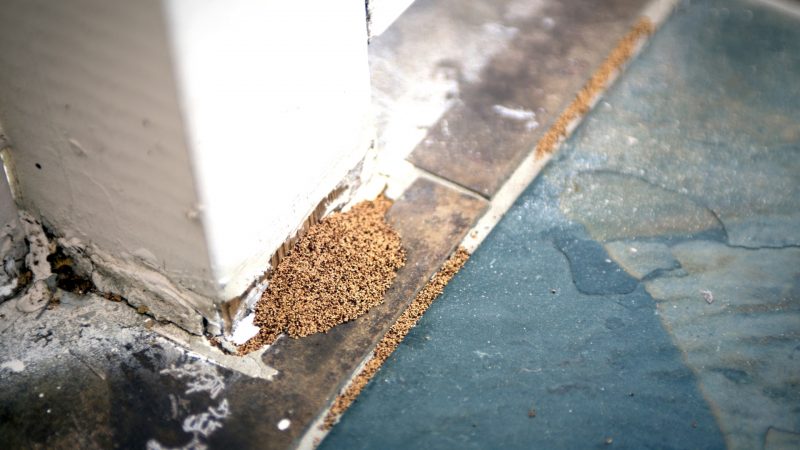
People often wonder, “Do termites leave dust?” Others mistakenly refer to termite droppings as “termite sawdust.” Termites don’t actually leave sawdust behind them, and those piles of “termite sawdust” are more accurately described as piles of termite droppings.
The droppings look a lot like sawdust when seen with the naked eye, though, in reality, they’re more sand-like than sawdust-like. When seen under a microscope, though, it’s evident that their shape is different from the shape of sawdust. Still, seeing unexplainable piles that look like sand or sawdust is one of the signs of termites.
Carpenter Ant vs. Termite Droppings
Because they both look like piles of sawdust, it can be difficult at first glance to identify ant droppings vs. termite droppings. On closer inspection, though, the differences are obvious.
Termite droppings are small, six-sided, oval-shaped pellets of excrement. Carpenter ants, however, don’t eat wood. Instead, they chew through it to burrow and make nests, so the sawdust they leave behind is actual sawdust from the wood they chewed but didn’t eat.
Which Other Insects Create Sawdust?
Aside from carpenter ants, the only other insects that create sawdust are carpenter bees and wood-boring beetles. Carpenter bees tunnel into wood to lay their eggs, creating sawdust in the process. Wood-boring beetles generally hatch inside wooden furniture and other wooded areas, feed on the wood as larvae, and chew their way out as adults.
Visual Differences Between Termite Excrements (Frass) and Sawdust
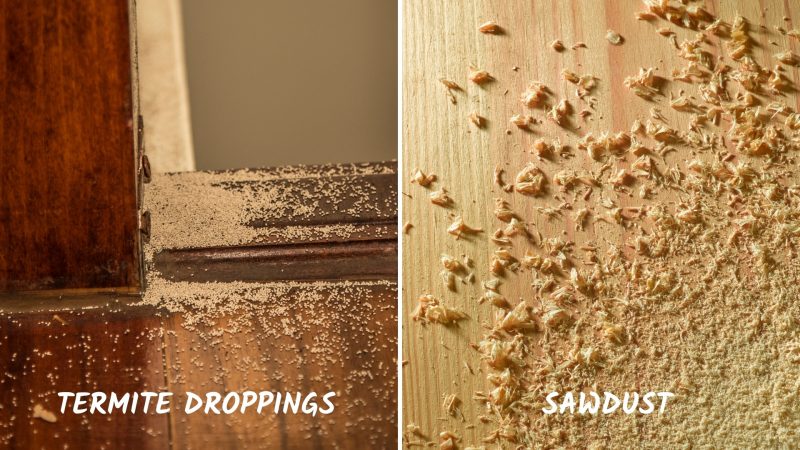
Because the color of a termite’s droppings depends on the color of the wood it’s been eating, color isn’t the best way to tell the difference between piles of termite poop and piles of sawdust. Instead, you’ll want to look at the shape of the individual pellets within the pile. Sawdust looks like slivers, splinters, and wood shavings. Termite poop is oval-shaped and six-sided.
Termite Eggs or Droppings: How To Differentiate
Unless you’re digging under the ground or looking inside your walls, it’s unlikely that you’ll ever run across any termite eggs because termites don’t lay them anywhere where people can easily see them.
So if you notice piles of something in your house, it’s almost certainly going to be droppings, not eggs. If you do run across the eggs, they usually look like tiny clusters of white powder. Under a microscope, they look like translucent white and brown capsules.
Types of Termite Droppings (Frass) or Pellets
Termite poop comes in two different forms, depending on which type of termite is excreting it.
Drywood Termite Droppings
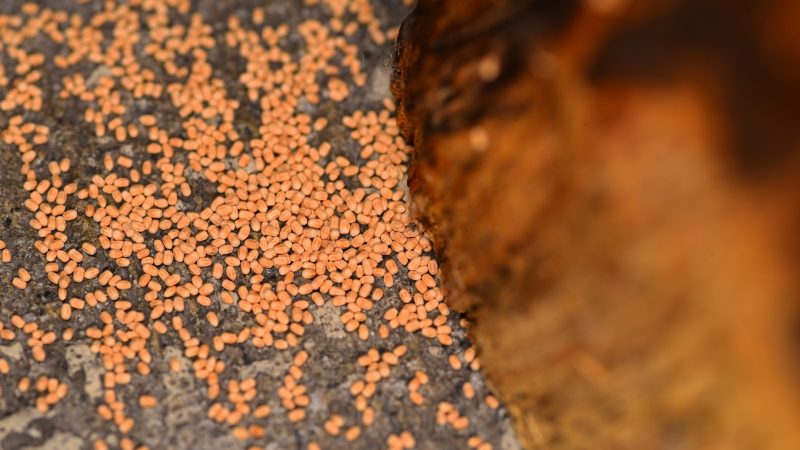
Drywood termites produce termite pellets, which are the small, sand-/sawdust-like droppings you might see piled up on the floor. These pellets are more commonly known as “frass.” You can find frass termite droppings inside your home, outside the house, inside the walls, or anywhere else termites live and feed.
Subterranean Termite Droppings
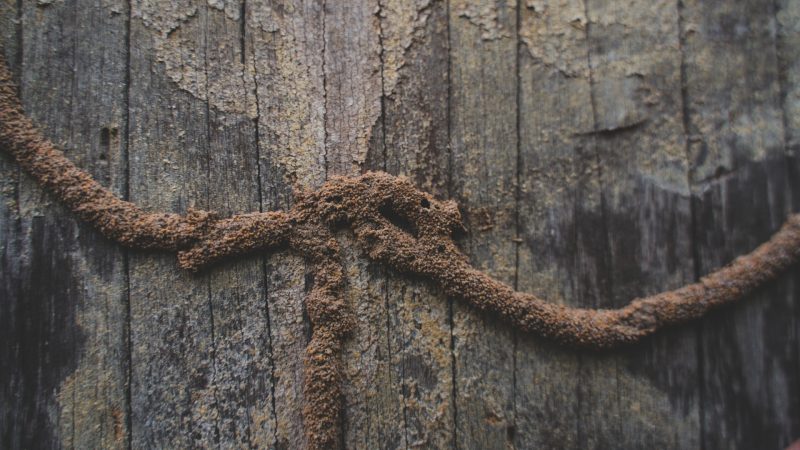
Subterranean, or damp wood termite pellets, aren’t actually pellets at all. Instead, these termites produce a type of liquid feces that they then use to help build their mud tubes. So if you’re looking for evidence of subterranean termites in your home, you won’t find it in pellets. You can spot the mud tubes, though, if you start looking around underneath your floors.
Are Termite Droppings a Health Hazard?
Two questions people regularly ask us are, “Can termite droppings make you sick?” and “Are termite droppings dangerous?” In and of itself, termite poop isn’t all that dangerous. It is, however, indicative of a much larger problem that could be attacking the underlying structure of your home, and that‘s dangerous.
As for the poop itself, unless you’re allergic to it or have asthma, you’re probably not at risk of coming into contact with it. However, because it’s small and dust-like, it can trigger asthma attacks, and allergic reactions can always cause problems no matter how “safe” a substance is; if you’re allergic to it, it’s going to make you sick. But aside from those two things, termite poop is more of a nuisance than a genuine danger.
What To Do if You Find Termite Droppings
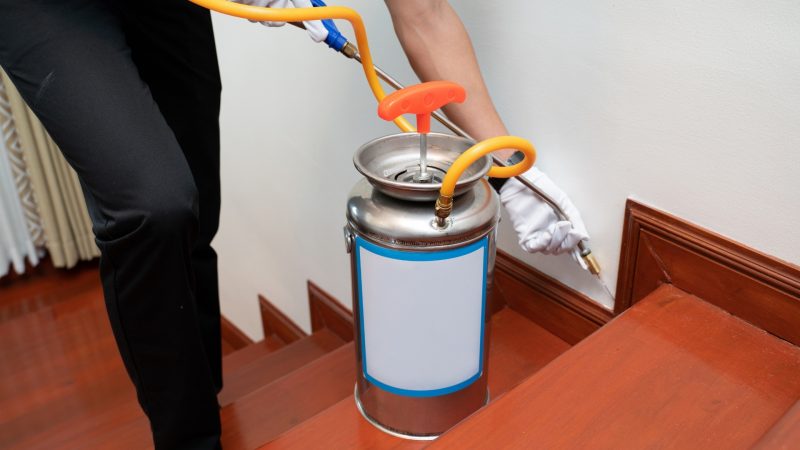
Termites are no joke, and if left untreated, they can destroy your home much more quickly than you can even imagine. So if you discover termite droppings in your home, the best thing you can do is hold off on cleaning the droppings and call a professional pest control company to examine them immediately.
Of course, there are products you can buy and use yourself, including BioAdvanced Termite Killer and Spectracide Termite Detection and Killing Stakes, which are both easy to use. However, we believe that it’s best to let professionals handle termite problems.
- EASY TO USE GRANULES: Just sprinkle, water in and walk away
- FAST RELEASING GRANULES: Kills termites with a single application
- EASY APPLICATION: Built-in 6-inch applicator makes treating up to...
- KILLS SUBTERRANEAN TERMITES: Kills multiple species with a single...
- Two termite products IN one: pop-up indicators detect termite...
- Installs IN minutes: place stakes in the ground 2 to 3 feet away...
- Pop-up indicator: check the stakes for termite activity when the...
- Complete kit: includes 15 stakes with locator shields,...
How To Clean Up Termite Droppings
If you’re dealing with dry wood termite pellets, they’re pretty easy to clean. Unless you find them in an awkward, hard-to-reach area, you can usually sweep them or vacuum them up without too much trouble.
As we’ve already mentioned, termite poop isn’t usually a health hazard, but it’s still kind of gross to have around the house. For that reason, after you’ve removed the droppings, you’ll want to clean the area thoroughly with a good, multi-purpose cleaner. We like to use Mrs. Meyer’s Multi-Surface Cleaner Spray or Lysol Multi-Purpose Cleaner Spray.
- Quick and easy multi surface spray removes stuck on dirt
- A fresh way to clean, refresh, and remove odors from non-porous...
- Garden-fresh lemon verbena has a light, refreshingly mild citrus...
- Safe to use as a floor cleaner, tile cleaner, on countertops,...
- Mrs. Meyer's produces cruelty free cleaners. None of our products...
No products found.
The mud tubes created by subterranean termites are a little harder to clean up than the frass left by dry wood termites. Luckily, if you call a professional pest control company, they’ll usually take care of the mud tubes as part of the package for cleaning up and ridding your home of termites.
List of Sources
Gouge, D.H., Olson, C., Baker, P. (2009). Drywood Termites. Cooperative Extension, College of Agriculture & Life Sciences, The University of Arizona.
Chan, W.H., Koehler, P.G., Tucker, C.L. (2016). Subterranean Termites. Department of Entomology and Nematology, University of Florida.
Utah Department of Agriculture and Food. (2009). Wood Destroying Pest Management.
United States Environmental Protection Agency. (2021). Termites: How to Identify and Control Them.
- Bed Bug Surge 2025: How to Detect, Prevent, and Safely Eliminate Infestations in Top U.S. Cities - June 18, 2025
- Asian Needle Ants Invade US Homes: 2025 Guide to Identification, Risks, and Effective Control - June 11, 2025
- New World Screwworm Alert: How US Livestock Owners Can Prevent Outbreaks and Protect Herds [Summer 2025 Update] - June 8, 2025




